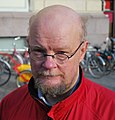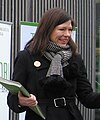Green League
Green League Finnish: Vihreä liitto Swedish: Gröna förbundet | |
|---|---|
| Abbreviation | VIHR |
| Chairperson | Maria Ohisalo |
| Secretary | Veli Liikanen |
| Vice-chairperson | Riikka Karppinen |
| Vice-chairperson | Fatim Diarra |
| Vice-chairperson | Jaakko Mustakallio |
| Chairperson of the party council | Silja Keränen |
| Founded | 28 February 1987 |
| Legalized | 1988 |
| Headquarters | Fredrikinkatu 33, Helsinki |
| Newspaper | Vihreä; formerly Vihreä Lanka |
| Youth wing | Vihreät Nuoret |
| Women's wing | Vihreät naiset |
| Membership (2020) | 9,000[1] |
| Ideology |
|
| Political position | Centre to centre-left |
| European affiliation | European Green Party |
| International affiliation | Global Greens |
| European Parliament group | Greens–European Free Alliance |
| Nordic affiliation | Centre Group |
| Colors | Green |
| Slogan | Neljän vuodenajan puolesta (For the four seasons) |
| Eduskunta | 20 / 200
|
| European Parliament | 3 / 14
|
| Municipalities | 432 / 8,999
|
| Website | |
| https://www.vihreat.fi/ | |
| |
| Part of a series on |
| Green politics |
|---|
 |
The Green League (VIHR, Finnish: Vihreä liitto [ˈʋihreæ ˈliːtːo], Swedish: Gröna förbundet), shortened to the Greens,[2] is a green political party in Finland.[3][4][5]
Ideologically, the Green League is positioned between the centre[6] and centre-left on the political spectrum.[7] It is a reformist party and it is supportive of feminism, animal rights and green liberal ideas.[6] Originally split on whether Finland should join the European Union, the Green League is pro-European and was the first Finnish party in favor of the federalisation of the European Union.[8][9] The Green League is among the large political parties in Finland. The Greens hold twenty seats in the Finnish Parliament and three in the European Parliament. The party is a member of the Global Greens and the European Green Party, while their MEPs, Heidi Hautala and Ville Niinistö sit with The Greens–European Free Alliance in the European Parliament.
Founded in 1987, the party absorbed a number of green organizations and their members, including four MPs elected in 1987. The party won ten seats in the 1991 election. Despite small losses in the in 1995 election, Pekka Haavisto joined Paavo Lipponen's first cabinet, which was composed of a rainbow coalition. This made the Green League the first green party to form part of a national cabinet. The party remained in government until 2002 when it resigned in opposition to nuclear power. The party slowly rose in popularity between 1995 and 2007, when winning a total of 15 seats, and joined the center-right-led government. In the 2011 election, the party suffered significant losses, falling to ten seats, but remained in government. In 2015, the party recovered its losses from 2011, returning to 15 seats. In the 2019 election, the party achieved by far its best-ever result, winning 20 seats and 11.5% of the vote. They became the fifth-largest party and became the third-largest member of the Social Democratic-led government.
In 2017 municipal elections the Green League was the fourth biggest party with 534 seats. They gained 211 more seats from 2012 elections.
Since June 2019, the party’s leader and chairman has been Maria Ohisalo.[10] From 2015 to 2019, the party was in opposition, and provided vast criticism regarding the actions of the incumbent right-wing Sipilä Cabinet such as financial support for economically well-off companies, Fortum's purchase of Uniper, and the expedited process of constitution-changing surveillance laws.[11][12][13]
History[]
Founding[]
The Green League was founded on 28 February 1987 and was registered as a political party the next year. Political activity had begun already in the early 1980s, when environmental activists, feminists, disillusioned young politicians from the marginalized Liberal People's Party and other active groups began to campaign on green issues in Finland. In 1995, it was the first European green party to be part of a state-level cabinet.
The party was founded as a popular movement, which explains its name's descriptor liitto, "league". Initially, there was much resistance within the movement against the founding of a political party, motivated by Robert Michels' iron law of oligarchy, which claims that movements inevitably degenerate into oligarchies when they create a formal organization.[14] The party still especially stresses openness and democratic decision-making. Even though liitto has been dropped from the party's website and advertisements, the word still remains in the official name.
Early activities (1983–1994)[]
The first two parliamentary representatives were elected even before the registration, in the 1983 parliamentary election. These were the first independent representatives in the Finnish Parliament. In 1987 the number of seats rose to four, and in 1991 to ten.
About half of the party’s members were against Finland joining the European Union in 1994. Later, polls showed that most Greens were anti-Eurozone.[15] The party heads declined to fight against euro adoption.
As part of the Lipponen Cabinets (1995–2003)[]
In the 1995 election, the Green League received a total of nine seats out of 200. The party joined the coalition cabinet led by the Social Democrats, and Pekka Haavisto became the Minister of the Environment,[16] thus becoming the first green minister in Europe.[citation needed]
The Green League received 7.3% of the vote, and gained two additional seats in the 1999 election, raising the total to 11. The Greens continued in the next coalition cabinet, but resigned in protest on 26 May 2002, after the cabinet's decision to allow the construction of a new nuclear plant was accepted by Parliament.
Growth to mainstream appeal (2003–present)[]
In 2003, the Green League received 8.0% of the vote, receiving a total of 14 seats. They increased their seats to 15 in the 2007 election while receiving 8.5% of the vote. In the 2011 election, the party lost five seats.
In the 2009 European Parliament elections, the Greens gained two of the thirteen Finnish seats in the European Parliament, which were occupied by Satu Hassi and Heidi Hautala.
At the municipal level, the Greens are an important player in the largest cities of Finland. In the municipal election of 2008 the Greens received 8.9% of the vote; the vote share was considerably higher in Helsinki, where the Greens became the second-largest party with 23.2% of the vote.[17] In several other cities, the Greens achieved the position of the third-largest party. Its weak spot is the rural countryside, particularly in those municipalities experiencing strong outward migration.
A 2012 study indicated that the Greens are the most popular party among journalists.[18]
By the 2017 Green League party congress, Niinistö had served three full two-year terms as the chairman and stepped down according to the rules of the party. In the following leadership election, there were six candidates running for party chair, of whom MP Touko Aalto won the election.[19]
Soon after Aalto's election, the popularity of the Green League surged in the polls and raised briefly as the second most popular party in the country.[20] However, in September 2017 the poll numbers turned into a downward slope, which continued until autumn 2018.[21] After taking a month of sick leave due to exhaustion in September 2018, Aalto soon announced that he was resigning from his post, citing depression and fatigue.[22]
In November 2018, the Green League decided to choose a temporary chairman to lead the party into the 2019 parliamentary elections and until the next party convention. In the leadership election, former chairman Pekka Haavisto was once again elected as chairman.[23]
In June 2019, Haavisto stepped down as the chairman of the party. Maria Ohisalo was the only candidate in the leadership election and was thus elected as chairman.[10]
Ideology and policies[]

The Green League is no longer a protest party, nor an alternative movement. Some Green candidates reject classifying the party as either left-wing or right-wing. Economic opinions of the members range between left and right.[14] However, members of the party on average place their party left of the Social Democrats and right of the Left Alliance.[24] In comparison with some other European green parties, Finland's Greens are noticeably more pro-European and centrist.
In the chamber of the Parliament and assembly rooms of local councils, Green representatives sit between the Finns and the Social Democrats.
The party is one of the strongest proponents for same-sex marriage. The party is also distinct in its opposition against universal male conscription and wants to opt for a gender-neutral, selective version. The eventual goal of the Greens is voluntary military service.
In 2015, the party included universal basic income as a proposal in their platform.[25]
In the spring of 2018, the party proposed lowering the voting age to 15.[26]
Election results[]
Parliamentary elections[]

| Election | Votes | % | Seats | +/- | Government |
|---|---|---|---|---|---|
| 1983 | 43,754 | 1.47 | 2 / 200
|
Opposition | |
| 1987 | 115,988 | 4.03 | 4 / 200
|
Opposition | |
| 1991 | 185,894 | 6.82 | 10 / 200
|
Opposition | |
| 1995 | 181,198 | 6.52 | 9 / 200
|
Coalition | |
| 1999 | 194,846 | 7.27 | 11 / 200
|
Coalition | |
| 2003 | 223,846 | 8.01 | 14 / 200
|
Opposition | |
| 2007 | 234,429 | 8.46 | 15 / 200
|
Coalition | |
| 2011 | 213,172 | 7.25 | 10 / 200
|
Coalition (2011–2014) | |
| Opposition (2014–2015) | |||||
| 2015 | 253,102 | 8.53 | 15 / 200
|
Opposition | |
| 2019 | 354,194 | 11.49 | 20 / 200
|
Coalition |
Municipal elections[]

| Election | Councillors | Votes | % |
|---|---|---|---|
| 101 | 76,441 | 2.8 | |
| 94 | 61,581 | 2.3 | |
| 1992 | 343 | 184,787 | 6.9 |
| 1996 | 292 | 149,334 | 6.3 |
| 2000 | 338 | 171,707 | 7.7 |
| 2004 | 313 | 175,933 | 7.4 |
| 2008 | 370 | 228,277 | 8.9 |
| 2012 | 323 | 213,100 | 8.5 |
| 2017 | 534 | 320,235 | 12.5 |
| 2021 | 432 | 258,624 | 10,6 |
European Parliament elections[]

| Election | Votes | % | Seats | +/- | Notes |
|---|---|---|---|---|---|
| 1996 | 170,670 | 7.6 | 1 / 16
|
||
| 1999 | 166,786 | 13.4 | 2 / 16
|
||
| 2004 | 172,844 | 10.4 | 1 / 14
|
||
| 2009 | 206,439 | 12.4 | 2 / 13
|
||
| 2014 | 160,967 | 9.3 | 1 / 13
|
||
| 2019 | 292,892 | 16.0 | 2 / 13
|
[27] |
Presidential elections[]
Parliamentarian and then-former MEP Heidi Hautala was a candidate in the presidential elections in 2000 and 2006, taking approximately a 3.5% share of votes in the first round in each. Pekka Haavisto was the first Green candidate in the 2012 election to enter the second round. Haavisto got an 18.8% share of votes in the first round, and lost to centre-right Sauli Niinistö in the second round held on 5 February.
| Election | Candidate | 1st round | 2nd round | ||
|---|---|---|---|---|---|
| Votes | % | Votes | % | ||
| 2000 | Heidi Hautala | 100,740 | 3.3 (#5) | ||
| 2006 | Heidi Hautala | 105,248 | 3.5 (#4) | ||
| 2012 | Pekka Haavisto | 574,275 | 18.8 (#2) | 1,077,425 | 37.4 (#2) |
| 2018 | Pekka Haavisto | 370,823 | 12.4 (#2) | ||
Politicians[]
List of party chairs[]

Kalle Könkkölä
(1987)
Heidi Hautala
(1987–1991)
Pekka Sauri
(1991–1993)
Pekka Haavisto
(1993–1995, 2018–2019)
Tuija Brax
(1995–1997)
Satu Hassi
(1997–2001)
Osmo Soininvaara
(2001–2005)
Tarja Cronberg
(2005–2009)Anni Sinnemäki
(2009–2011)
Ville Niinistö
(2011–2017)
Touko Aalto
(2017–2018)
Maria Ohisalo
(2019–)
Current members of Parliament[]
The following 20 Greens politicians were elected to the Finnish Parliament in the 2019 parliamentary election. 16 out of 20 members are first-timers. 17 of the members are women.[28]

Pekka Haavisto
(Minister for Foreign Affairs)
Maria Ohisalo
(Minister of the Interior)
(New)
Mari Holopainen
(New)
Pirkka-Pekka Petelius
(New)
Inka Hopsu
(New)
Iiris Suomela
(New)
Satu Hassi

Atte Harjanne
(New)
Noora Koponen
(New)
Saara Hyrkkö
(New)
Bella Forsgrén
(New)
Sofia Virta
(New)
Tiina Elo
(New)
Jenni Pitko
(New)
Hanna Holopainen
(New)
Mirka Soinikoski
(New)
Current members of the European Parliament[]
Since 2020, the Green League has been represented by three MEPs in the European Parliament.

Heidi Hautala
See also[]
- Green politics
- Politics of Finland
- List of environmental organizations
- Pentti Linkola
- Kirjava ”Puolue” – Elonkehän Puolesta
References[]
- ^ "Tietoah Vihreista". Vihreat De Grona. Vihreat De Grona. Retrieved 29 May 2020.
- ^ "Yle party poll: Centre recovers as Greens, Finns Party falter". Yle Uutiset. Retrieved 2017-11-12.
- ^ Nordsieck, Wolfram (2019). "Finland". Parties and Elections in Europe.
- ^ Claire Annesley (11 January 2013). Political and Economic Dictionary of Western Europe. Routledge. pp. 177–. ISBN 978-1-135-35547-0.
- ^ Daniele Caramani (29 March 2004). The Nationalization of Politics: The Formation of National Electorates and Party Systems in Western Europe. Cambridge University Press. pp. 303–. ISBN 978-0-521-53520-5.
- ^ Jump up to: a b "Finland's largest political parties". European Parliament Information. 2014.
- ^ Jan-Erik Lane; Svante Errson (2008). "The Nordic Countries: Compromise and Corporatism in the Welfare State". In Josep M. Colomer (ed.). Comparative European Politics: Third Edition. Routledge. p. 260. ISBN 978-1-134-07354-2.
- ^ Raunio, Tapio; Tiilikainen, Teija (2003). Finland in the European Union. London: Routledge. p. 52. ISBN 978-0-7146-5375-4.
- ^ Raunio, Tapio; Tiilikainen, Teija (2003). Finland in the European Union. London: Routledge. p. 52. ISBN 978-0-7146-5375-4.
- ^ Jump up to: a b "Maria Ohisalo – parissa kuukaudessa ensin kansanedustajaksi, sitten ministeriksi ja nyt vihreiden puheenjohtajaksi". Yle Uutiset (in Finnish). Retrieved 2019-06-15.
- ^ "Nyt on oikea aika uudistaa perhevapaat ja yritystuet". Vihreät - De Gröna (in Finnish). 2017-06-27. Retrieved 2018-02-03.
- ^ "Fortumin Uniper-kauppa vesittää puhtaat lupaukset". Vihreät - De Gröna (in Finnish). 2017-10-09. Retrieved 2018-02-03.
- ^ "Perustelut tiedustelulain kiirehtimiselle puuttuvat". Vihreät - De Gröna (in Finnish). 2018-01-31. Retrieved 2018-02-03.
- ^ Jump up to: a b Rauli Mickelsson. Suomen puolueet - Historia, muutos ja nykypäivä. Vastapaino 2007, 429 pages.
- ^ "4.2 Suomi Euroopan Unionissa".
- ^ "Composition of a certain government, 66. Lipponen". Valtioneuvosto. Retrieved 2018-01-18.
- ^ "Vaalit 2008 tulospalvelu - Helsinki - Puolueiden kannatus" (in Finnish). Yle.fi. 2008-10-30. Retrieved 2013-12-23.
- ^ "Aamulehti" (in Finnish). Aamulehti.fi. Archived from the original on 2013-12-24. Retrieved 2013-12-23.
- ^ "Touko Aalto vihreiden puheenjohtajaksi" (in Finnish). Vihreät. 17 June 2017. Retrieved 17 June 2017.
- ^ "Vihreät nousi toiseksi suurimmaksi puolueeksi ja sai parin kuukauden aikana 80 000 uutta äänestäjää – Puheenjohtaja Aalto: "Isoa liikehdintää tapahtuu"". Helsingin Sanomat (in Finnish). 28 August 2017. Retrieved 25 October 2018.
- ^ "Touko Aallon 494 päivää vihreiden puheenjohtajana – pääministeripuheista syöksykierteeseen". Ilta-Sanomat (in Finnish). 24 October 2018. Retrieved 25 October 2018.
- ^ "Greens chair Touko Aalto steps down: "I need more time for recovery"". Yle. 24 October 2018. Retrieved 25 October 2018.
- ^ "Pekka Haavisto valittiin vihreiden johtoon murskaäänin 40–1 – puolueella on Touko Aallon uupumisen myötä "peiliin katsomisen paikka"". Yle. 4 November 2018. Retrieved 5 November 2018.
- ^ Elo, Kimmo – Rapeli, Lauri (2008): Suomalaisten politiikkatietämys. Oikeusministeriön julkaisuja 2008:6.
- ^ "Vihreät haluaa 560 euron perustulon kaikille". Kaleva.fi. Retrieved 24 February 2015.
- ^ "Vihreiden puoluehallitus: Äänestysikäraja laskettava 15 vuoteen". Ilta-Sanomat (in Finnish). 2018-05-27. Retrieved 2021-03-08.
- ^ "Results by party". Ministry of Justice - Information and Result Service. 2019-05-29.
- ^ "Eduskuntavaalit 2015". Yle. Retrieved 22 April 2015.
External links[]
- Official site (in Finnish)
- 1987 establishments in Finland
- Political parties established in 1987
- Green parties in Europe
- Registered political parties in Finland
- European Green Party
- Global Greens member parties
- Green liberalism
- Parties represented in the European Parliament
- Pro-European political parties in Finland

























